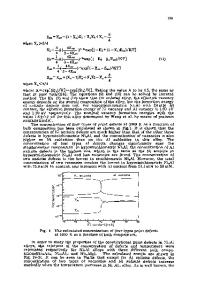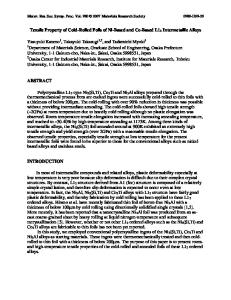Hydrogen embrittlement of pseudobinary l1 2 -type Ni 3 (Alo. 4 Mno.6) intermetallic compound
- PDF / 1,575,457 Bytes
- 6 Pages / 613 x 788.28 pts Page_size
- 37 Downloads / 385 Views
I.
INTRODUCTION
THE intermetallic compound Ni3A1 has been well known as the strengthening phase in the nickel base superalloys. This compound shows the unique property, that with increasing temperature the yield stress increases. ~ However, its brittle tendency due to the weakness of the grain boundaries has prevented it from practical uses. In order to overcome this problem, the present authors proposed the pseudobinary L12-type Ni3(A1, Mn) compounds alloyed with the manganese atom and showed their ductilization without spoiling the positive temperature dependence of the yield strength. 2 Recently, the hydrogen embrittlement for the L12-type intermetallic compounds and ordered alloys has been regarded as a serious problem from the scientific and also practical points of view; these alloys are easily embrittied by the hydrogen, causing intergranular fracture. Kuruvilla et al. first pointed out this problem in the L12-type (Fe, Ni)3V ordered alloy and showed that the ordered state was more susceptible to the hydrogen embrittlement than its disordered state. 3 Miller et al. reported that the perfect ordered and disordered states were most susceptible and the intermediate ordered state was least susceptible in the Ni2Cr alloy forming an orthorhombic ordered structure. 4 Kuruvilla et al. also investigated the hydrogen effect in the Ni3A1 micro-alloyed with boron and showed that this alloy was severely embrittled by the hydrogen through the intergranular fracture, s Also, Takasugi et al. recently reported that the L12-type C03Ti was embrittled by the cathodically charged hydrogen and even by the residual hydrogen in the alloy, and proposed that the 'deformable' L12-type intermetallic compounds and ordered alloys should all more or
N. MASAHASHI, formerly Graduate Student with Tohoku University, Sendai, Japan, is with Nippon Steel Corporation, Kawasaki, Kanagawa, Japan. T. TAKASUGI, Research Associate, and O. IZUMI, Professor, are with Institute for Materials Research, Tohoku University, Sendai 980, Japan. Manuscript submitted September 8, 1986. METALLURGICALTRANSACTIONS A
less suffer from the hydrogen embrittlement. 6 They also investigated strong strain rate dependence, temperature dependence, and compositional effect on the hydrogen embrittlement of the C03Ti. 7 According to their results, the ultimate tensile stress, the tensile elongation, and resultant fracture behavior were considerably affected by the hydrogen. In the light of these investigations, the hydrogen may affect the mechanical properties of the L 12-type Ni3(A1, Mn) compound which was ductilized by the addition of manganese to the Ni3A1. In the present work, the dependences of the mechanical properties on the environment (air, vacuum, or cathodic charging of hydrogen) and strain rate were examined at room temperature by tensile test. The mechanical properties were characterized by the elongation, the yield stress, and the ultimate tensile stress and then correlated with the fracture behavior.
II.
EXPERIMENTAL PROCEDURE
The alloy composition of 75
Data Loading...











